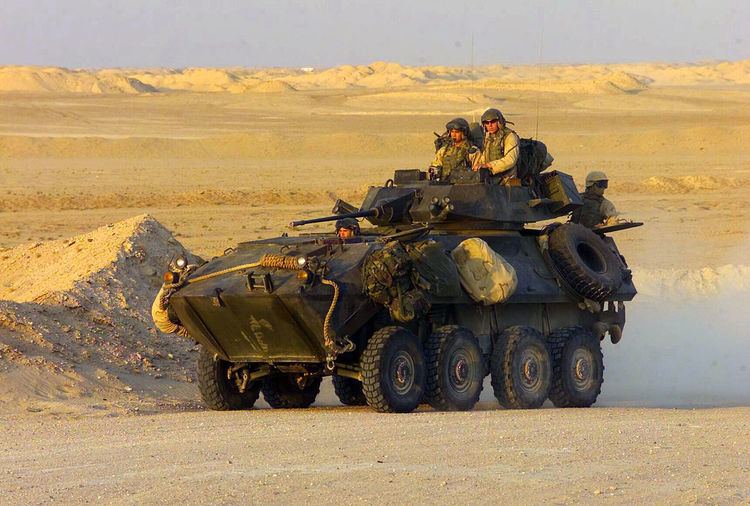Place of origin Canada Length 6.39 m (21 ft 0 in) | In service 1983–present Width 2.50 m (8 ft 2 in) | |
 | ||
Weight | ||
The LAV-25 (Light Armored Vehicle) is an eight-wheeled amphibious armored reconnaissance vehicle used by the United States Marine Corps and Canadian Army. It was built by General Dynamics Land Systems Canada and is based on the Swiss MOWAG Piranha I 8×8 family of armored fighting vehicles.
Contents
GDLS also makes the LAV III armored vehicle that is based on MOWAG Piranha IIIH 8×8.
History
During the 1980s, the US Marine Corps began looking for a light armored vehicle to give their divisions greater mobility. They chose the Light Armored Vehicle (LAV) based on the Swiss MOWAG Piranha. It entered service with the Marines in 1983. The U.S. Army was interested in these vehicles at the time, but did not order any (although they did later with introduction of the Stryker family of vehicles). The U.S. Army did, however, borrow at least a dozen LAV-25s for use in the 82nd Airborne's, 73rd Cavalry Regiment for a Scout Platoon during the Gulf War. These LAV-25s were later returned to the Marine Corps after the Gulf War. The USMC ordered 758 vehicles of all variants. LAVs first saw combat during the Invasion of Panama in 1989, and continued service in the Gulf War, Iraq War, and the War in Afghanistan.
The table of organization and equipment for an USMC light-armored reconnaissance battalion includes 56 LAV-25s, 16 LAV-ATs, 12 LAV-Ls, 8 LAV-Ms, 4 LAV-Rs, 4 LAV-C2s, and an unknown number of LAV-MEWSS vehicles.
The LAV platform is planned to remain in service with the Marine Corps until 2035.
Design
Powered by a 6V53T Detroit Diesel turbo-charged engine, they are 4-wheel drive (rear wheels) transferable to 8-wheel drive. These vehicles are also amphibious, meaning they have the ability to "swim", but are limited to non-surf bodies of water (no oceans). While engaged in amphibious operations, the maximum speed is approximately 12 km/h (7.5 mph) using equipped propellers. The current SLEP (Service Life Extension Program) modifications will hinder or eliminate amphibious ops.
Typical land speeds are approximately 100 km/h (62.5 mph) in either 4- or 8-wheel drive; however, fuel economy decreases in 8-wheel drive. The vehicles operate on diesel fuel. They are equipped with a M242 Bushmaster 25 mm cannon, two M240 7.62 mm machine guns, and two 4-barrel smoke grenade launchers located on the forward left and right sides of the turret. The crew is three; vehicle commander (VC), gunner, and driver; and four passengers (scouts) with combat gear.
Armor
The LAV-25 is a lightly armored vehicle. The base model is protected by light gage high hardness steel armor (MIL-A-46100), varying in nominal thickness from 4.71 mm to 9.71 mm. This level of high-hardness steel armor is intended only to offer protection against small arms rounds such as the common 7.62x39mm M1943 ball used by the AKM, to achieve the lowest possible weight and cost.
LAV-25
Standard LAV fitted with a turret with 360° traverse, armed with an M242 25 mm chain gun with 420 rounds of 25 mm ammunition, both M791 APDS-T (Armour Piercing Discarding Sabot-Tracer) and M792 HEI-T (High Explosive Incendiary-Tracer), of which half is ready for use. One hundred fifty rounds are ready for use from one stowage bin, 60 from another stowage bin, the other 210 rounds are stowed elsewhere in the vehicle. A coaxial M240C machine gun is mounted alongside the M242, and a pintle-mounted M240B/G machine gun, with 1,320 rounds of 7.62 mm ammunition, is mounted on the turret roof. The Canadian Army uses an upgraded version of this chassis for its Coyote Armoured Reconnaissance Vehicle.
LAV-25A1
The vehicle has been through many changes through the late 1990s. The new modification or SLEP has changed the LAV-25 to the LAV-25A1 standard and has been completely fielded.
LAV-25A2
Funding has been approved for continued upgrades to the LAV family to bring them up to the LAV-A2 standard. Phase I improvements include increased external and internal ballistic armor upgrades, improved fire suppression equipment, and upgrading the vehicle's suspension to the Generation II standard. Phase II upgrades include replacing the turret hydraulics with an electric drive system and replacing the thermal sight with an improved model incorporating a laser range finder for aircraft.
To reflect the improved significant survivability and capability enhancements occurring today, the LAV is being renamed as the LAV-A2. The LAV-A2 project involved developing and installing an internal and external ballistic protection upgrade package, developed by Armatec Survivability, for the Light Armored Vehicles, an automatic fire suppression system for the interior of the vehicle and a Generation II suspension upgrade to support the added weight of the new armor. The suspension upgrade includes new struts/steering knuckles, torsion bars, shocks and mounts and drive shaft. The three-kit armor system provides the LAV with additional survivability against improvised explosive devices (IED) and direct-fire kinetic energy weapons.
The LAV-25A2 includes the Improved Thermal Sight System (ITSS) developed by Raytheon, scheduled for fielding by the end of 2007. The ITSS provides the gunner and commander with thermal images, an eye-safe laser range finder, a fire-control solution and far-target location target grid information.
The new armor will provide protection from 14.5 mm armor-piercing rounds, and include an anti-spall lining on the inside to further protect crew members. It will be similar to the protection found on the U.S. Army's LAV III "Stryker" variant.
Derivatives
An unknown variant is used by at least one civilian law enforcement agency.
